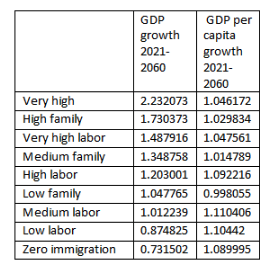Keeping migration low is the best way to raise Americans’ prosperity, says a study funded by the leading lobby group for investors who want mass migration.
“At medium and low immigration levels, labor-based [skilled professional] immigration, characterized by fewer but more skilled population, produces higher GDP [Gross Domestic Product] per capita [emphasis added] growth,” compared to mass inflow of migrants and their extended families, says the September study by Springer, titled “Demographic and Economic Implications of Alternative U.S. Immigration Policies.”
“That should be a no-brainer because we know we could annex Mexico and our GDP would be enormously higher, but our per capita income would drop,” said Rosemary Jenks, cofounder of the Immigration Accountability Project. “That’s just ‘Duh!’”
The study is useful because “you have the advocates [for mass migration] themselves saying immigration is not a good deal for the average American,” said Stephen Camarota, the research director at the Center for Immigration Studies. “It may be good for Wall Street, it’s not good for Main Street, ” he added.
The study matches reality in Canada, Australia, and the United Kingdom, where the estimated quality of life is declining and productivity is stalling because elites are importing consumers, renters, and workers to grow the nation’s real-estate prices and stock values.
FWD.us
The pro-migration report credits the education-fund spinoff of FWD.us for its creation, saying, “This research was supported by a grant from the FWD.us Education Fund.”
FWD.us was created by West Coast investors to lobby for a greater inflow of consumers, renters, and workers.
It was initially pushed by Facebook founder Mark Zuckerberg to pass the 2013 “Gang of Eight” amnesty bill. Since then, Zuckerberg has reportedly stepped back from the organization, ceding a greater role to other investor founders. The other leaders include venture capitalists Ron Conway and Reid Hoffman, and Salesforce founder Marc Benioff.
The group reveals very little about its funding or backers, or operations. But the report thanked the lobby group’s staff, including president Todd Schulte and advocacy chief Mark Delich:
The authors would like to thank Todd Schulte, Mark Delich, Phillip Connor, Pete Boorgard, Andrew Moriarity, Eddie Taveras, and two anonymous reviewers for their feedback on the manuscript at various stages. We also thank Giovanni Peri for his advice on modeling, and Tim O’Shea and Nowrin Fatema for research assistance.
The study looks at economic growth from 2021 to 2060, and concludes that GDP [the blue line] is maximized by mass immigration of families who must work to rent apartments and pay living expenses.
But per-capita income [the red line] is maximized by a smaller inflow of working-age, skilled workers, the FWD.us report admitted: “GDP grows faster in policy scenarios with higher immigration.”
The report’s scenarios consider unskilled mass migration — “family emphasis” — and skilled migration, dubbed “labor” migration. “Compared to the family emphasis scenarios, the labor-emphasis scenarios predict that immigration will be more concentrated in the prime working ages and include more Asian and European immigrants, and fewer Latin Americans,” the study adds.
The report concludes:
All family-emphasis scenarios experience slower GDP per capita growth compared to both their [skilled] labor counterparts and the zero immigration scenario, primarily due to larger population sizes and lower supplies of working-age populations.
In fact, the option of zero immigration generates higher per-capita growth than the GDP-boosting option of mass family migration, according to the study.
The report says the zero migration option grows per-capita income by 1.089 in the 35 years up to 2060.
Cutting immigration to half the 2021 level but emphasizing skilled migrants raises per capita result by 0.01.
Keeping migration at President Joe Biden’s 2021 rate but emphasizing skilled foreign workers raises per capita income by another 0.06, the study says:

The new study matches prior work by the FWD.us group and its education fund.
In November 2024, a FWD.us report agreed that migration drives down wages:
When labor is in short supply relative to demand, employers offer higher wages, which are in turn passed on to consumers, leading to rising prices … Congress and the Biden Administration should immediately find legislative solutions to increase legal immigration, or risk future inflationary spikes.
In February 2020, for example, Breitbart News reported that a FWD.us study showing the exclusion of migrants in Florida would drive up local wages:
If “existing undocumented workers were to exit the Florida economy in the number anticipated were E-Verify were [sic] to be adopted, the adequate numbers of native workers would not be available at current wage rates,” says the draft report funded by FWD.us, an advocacy group for billionaire investors, including Mark Zuckerberg.
…
“In today’s tight labor market, it is unlikely that the workforce lost due to the implementation of mandatory E-verify would be replaced without driving up production costs,” according to the report, which was commissioned by FWD.us in November 2019 in response to DeSantis’s push for legislation that would reduce the hiring of illegal migrants.
In April 2021, another FWD.us-funded study from George Mason University showed that mass migration helps to inflate the U.S. economy, for example, by raising land values and rental income. A bigger economy is good for property owners, investors, and banks — but forces ordinary citizens to deal with more expensive housing, chaotic politics, more wage competition, and crowded roads, amenities, schools, and hospitals.
But the 2021 report also admitted that mass migration does little for per-capita growth:
Projections show that U.S. gross domestic product (GDP) could double and grow as large as $47 trillion in today’s dollars in 2050 if immigration levels were doubled to more than 2 million new permanent and temporary immigrants each year. Per capita, this would lead to a 3% increase in average income by 2050 for all Americans compared with keeping immigration at recent levels.
But a 3 percent gain over 30 years is just 0.1 percent a year amid the huge civic and pocketbook costs of higher migration.
The 2021 report’s promise of a 3 percent per-capita gain over 30 years “is a tiny, trivial per-capita benefit … it is so small that it’s within any kind of margin of error,” said Stephen Camarota, the research director at the Center for Immigration Studies. He added:
There’s no evidence this [migration] makes the average American more prosperous, and in fact, it almost certainly makes the working class worse off by increasing job competition … There’s many consequences to adding to the U.S. population, including making housing more unaffordable, congestion, pollution, sprawl, and none of that is being accounted for here … There’s even evidence that immigration reduces the fertility of the native born.
The non-economic costs include chaotic diversity, reduced innovation, stagnant wages, unaffordable housing, fewer births, and limited opportunities for upward mobility among young strivers.
For example, Americans’ housing costs rose dramatically under President Joe Biden’s supercharged economic policy of Extraction Migration. The total value of U.S. housing rose by 56 percent from 2020 to late 2025, Zillow reported in September. A Danish study reported that a lower level of migration spiked housing costs by 30 percent. The same trend is seen in high-migration Australia.
But amid Trump’s low-migration policies, “growth has slowed in the past year as high costs cooled buyer demand,” Zillow added. “Rents in Doral have dropped to their lowest level in three years,” the Wall Street Journal reported as it charted the self-deportation of many Venezuelan migrants.
The 2025 and 2021 reports are silent about the increased costs imposed by greater migration. The 2025 report also assumed productivity would grow at 1.4 percent per year.
Still, both the 2025 and 2021 reports touted benefits for decision-makers and political advocates in Washington, DC.
The 2025 report says:
U.S. economic growth and our continued global economic leadership depend on expanding opportunity supported by a sufficiently large working-age population, which means implementing humane, orderly ways to increase immigration levels of all kinds.
The 2021 report says, “By increasing immigration — and by creating a humane, orderly system for employment- and family-based immigration — the United States can maintain its global leadership and invest in a strong economic future for all Americans.”
“We don’t give a damn what the GDP is — we care what our per-capita income is,” said Jenks, adding:
I think the elites care about the overall GDP …Well, who cares if it’s not helping us? This is what the 1940s and 50s were all about — [because] after we got out of the war and immigration was at historic lows, the middle class started growing.
Other reports also say massive migration inflows generate tiny economic gains. For example, a 2024 Brookings report by economist Wendy Edelburg criticized Trump’s immigration policy, saying it “could cause GDP growth in 2025 to be roughly half a percentage point … lower in a second Trump administration than under a [Kamala] Harris administration.” The report did not mention per-capita gains or losses.
In July, Edelberg told Bloomberg News that Trump’s deportations would have “pretty modest economic effects” on the overall size of the nation’s economy. But, she added, “We’re going to see stronger wage growth in some occupations, stronger wage growth in the agricultural sector, stronger wage growth for home health workers.”
“Immigration does not make countries rich,” said Camarota, adding:
It doesn’t make countries necessarily more productive, it just makes their population and GDP bigger. If you want to try to use immigration to make yourself richer, then you mean a much lower level and a highly selective system.
Moreover, the 2025 FWD.us report also admits alternatives to their favored policy of more migration. “Immigration is not the only approach to address labor shortages and population aging: improving labor force participation can have positive and long-term effects on the economy [and] increasing fertility among the native-born would slow population aging,” the report said.
President Donald Trump is zig-zagging towards that economic alternative to migration.
“We’re going to need robots … to make our economy run because we do not have enough people,” he told Breitbart News, adding:
So we have to get efficient … we’ll probably add to [the existing workforce] through robotically—it’s going to be robotically … It’s going to be big. Then, somebody is going to have to make the robots. The whole thing, it feeds on itself.
Notably, Trump’s Labor Department posted a September 30 tweet saying, “America First. Americans First.”
Read the full article here


